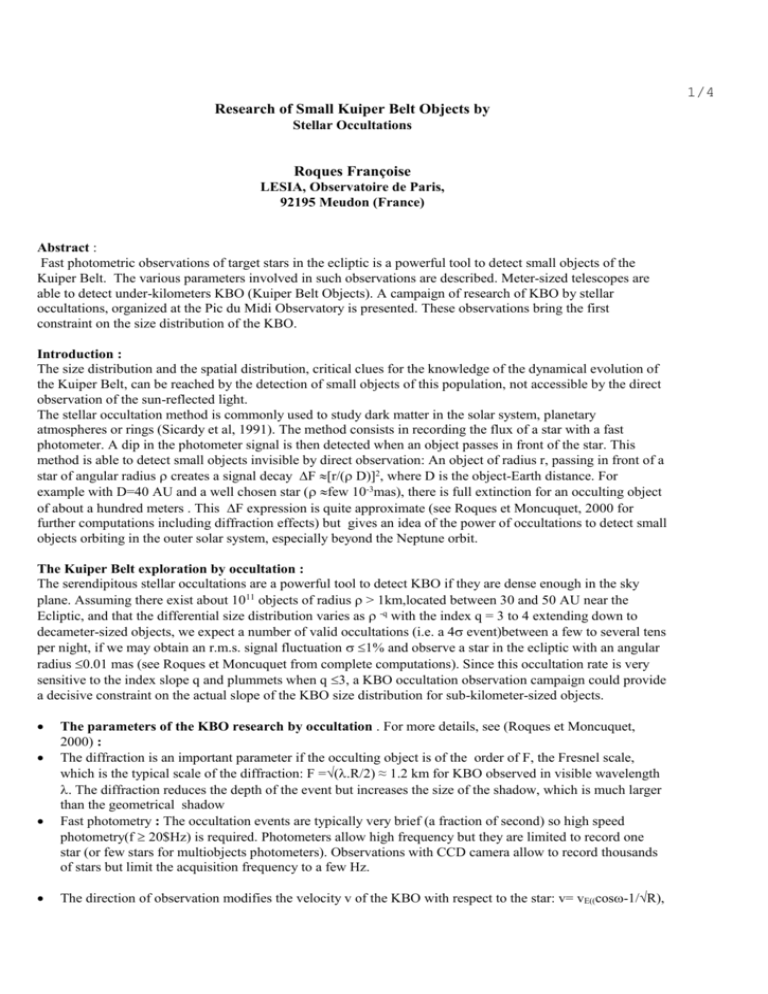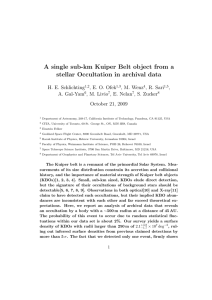Search for KBO occultations, first results.
advertisement

1/4 Research of Small Kuiper Belt Objects by Stellar Occultations Roques Françoise LESIA, Observatoire de Paris, 92195 Meudon (France) Abstract : Fast photometric observations of target stars in the ecliptic is a powerful tool to detect small objects of the Kuiper Belt. The various parameters involved in such observations are described. Meter-sized telescopes are able to detect under-kilometers KBO (Kuiper Belt Objects). A campaign of research of KBO by stellar occultations, organized at the Pic du Midi Observatory is presented. These observations bring the first constraint on the size distribution of the KBO. Introduction : The size distribution and the spatial distribution, critical clues for the knowledge of the dynamical evolution of the Kuiper Belt, can be reached by the detection of small objects of this population, not accessible by the direct observation of the sun-reflected light. The stellar occultation method is commonly used to study dark matter in the solar system, planetary atmospheres or rings (Sicardy et al, 1991). The method consists in recording the flux of a star with a fast photometer. A dip in the photometer signal is then detected when an object passes in front of the star. This method is able to detect small objects invisible by direct observation: An object of radius r, passing in front of a star of angular radius creates a signal decay F [r/( D)]2, where D is the object-Earth distance. For example with D=40 AU and a well chosen star ( few 10-3mas), there is full extinction for an occulting object of about a hundred meters . This F expression is quite approximate (see Roques et Moncuquet, 2000 for further computations including diffraction effects) but gives an idea of the power of occultations to detect small objects orbiting in the outer solar system, especially beyond the Neptune orbit. The Kuiper Belt exploration by occultation : The serendipitous stellar occultations are a powerful tool to detect KBO if they are dense enough in the sky plane. Assuming there exist about 1011 objects of radius > 1km,located between 30 and 50 AU near the Ecliptic, and that the differential size distribution varies as -q with the index q = 3 to 4 extending down to decameter-sized objects, we expect a number of valid occultations (i.e. a 4 event)between a few to several tens per night, if we may obtain an r.m.s. signal fluctuation 1% and observe a star in the ecliptic with an angular radius 0.01 mas (see Roques et Moncuquet from complete computations). Since this occultation rate is very sensitive to the index slope q and plummets when q 3, a KBO occultation observation campaign could provide a decisive constraint on the actual slope of the KBO size distribution for sub-kilometer-sized objects. The parameters of the KBO research by occultation . For more details, see (Roques et Moncuquet, 2000) : The diffraction is an important parameter if the occulting object is of the order of F, the Fresnel scale, which is the typical scale of the diffraction: F =√(.R/2) ≈ 1.2 km for KBO observed in visible wavelength . The diffraction reduces the depth of the event but increases the size of the shadow, which is much larger than the geometrical shadow Fast photometry : The occultation events are typically very brief (a fraction of second) so high speed photometry(f 20$Hz) is required. Photometers allow high frequency but they are limited to record one star (or few stars for multiobjects photometers). Observations with CCD camera allow to record thousands of stars but limit the acquisition frequency to a few Hz. The direction of observation modifies the velocity v of the KBO with respect to the star: v= vE((cos-1/√R), 2/4 where vE is the Earth velocity, is the angle from opposition to the observation, and R is the radius of the KBO orbit in UA. The probability of occultation is proportional to v, but the occultation duration is inversely proportional to this velocity. Toward the opposition, the velocity and the occultation rate are maximum but the occultation duration is minimum. In the direction defined by cos=1/√R, the velocity of the KBO in limited to the velocity perpicular to the ecliptic plane. This effect could be used to distinguish a population of KBO from nearer or farther population. The star size is a critical parameter because the occultation profile is smoothed on the stellar disc. Occultations of large stars by under-kilometer KBO does not generate a detectable decrease of the stellar flux. Typical star radii are between 3.10-3 to 1 milliarcsecond. Projected at 40 AU, this corresponds to 0.1 to 30 km in radius.. Then, the research of small objects needs stellar candidates carefully chosen. The star must have a small angular diameter, but it must be bright enough to preserve a good lightcurve S/N. Blue stars are the best candidates, because for a given magnitude, they have the smaller angular diameter (table 1). Mv M5 star F5 star 05 star 8 50 km 4 km 800 m 10 20 km 2 km 300 m 12 8 km 700m 100m 14 3 km 100m 50m Table 1 :Apparent stellar radii projected at 40 AU The S/N of the lightcurve limits the detection of the dip. If the star is brighter then magnitude 12, the noise on a high time resolution lightcurve is dominated by scintillation which affects the stars independent of their brightness. The r.m.s. signal fluctuation observed with a telescope with a d diameter, at an altitude h above the sea level can be written as (Young, 1967): = S0 d-2/3 X3/2 e h/H (2 \) -1/2 where X is the airmass, is the integration time, H is taken to be 8 km. S0 is a constant equal to 0.09 for conditions of good seeing, d is in centimeters and is in seconds.For =0.05 second, the r.m.s. fluctuations on a 2.-m class telescope is roughly 2.10-2 for optimal conditions. This allow us to detect sub-kilometer objects. The largest ground-based telescopes (i.e. the 10-meters class telescopes) allow us to marginally reach 10-3 and then to detect about 40m radius KBOs (figure 1). If an occultation is observed at different wavelengths, the profiles are different and the comparison of the dip profiles could give information on the Fresnel scale and, then, on the distance of the occulting object. Figure 1 : synthetized light curve of a stellar occultation detectable with a Very Large Telescope (10-3). The KBO radius 3/4 is 40 meters radius KBO (from Roques et moncuquet, 2000) The Pic du Midi research campaign The observation consisted in recording the flux of a well chosen star with a fast photometer (20Hz) and to count occultations of this star by passing KBO. Observations have been organized at the Bernard Lyot 2m telescope (TBL) of the Pic du Midi observatory in september 2000 and simultaneous observation was organized with the 1 meter telescope (T1m), located 200m away from the TBL. The campaign provided 15 hours of good quality signal (rms 1.810 –2 ) and zero detections of KBO at a 4 sigma detection level. For a KBO differential size distribution assumed to vary as r-q, this first result suggests a slope q 4.5 (Roques et al., 2003). A potential occultation is detected at 3 (figure 4) which is compatible with a 150 meters radius KBO. figure 4 : normalized flux of the target star and the comparison star (shifted of 0.2). A dip with diffraction fringes is detected on the target light curve and non one is observed simultaneously on the comparison light curve (from Roques et al. 2003). Conclusions Stellar occultation technique is able to detect small objects of the Kuiper Belt and then, to strongly constraint the size distribution. The optimal conditions are high speed (at least 20 Hz) photometric observation of blue star of magnitude approx 12 (angular diameter smaller than 0.007 mas) of the ecliptic. The detection of hectometric KBOs is possible with medium size class telescopes. It needs to accumulate observations in good conditions using a well-defined and homogeneous analysis method. More generally, observation campaigns of stellar occultation by KBOs on larger telescopes (so scanning smaller objects) could statistically constrain the slope and the expected turnover radius due to collisional erosion of the small KBO size distribution. Observations organized at the Pic du Midi observatory in September 2000 led to a first trend on the slope q of the differential size distribution: Bibliography: - Roques, F., Moncuquet, M. 2000, A detection method for small Kuiper belt objects: The search for stellar occultations Icarus, 147, 530-544. - F. Roques, M. Moncuquet, N. Lavillonière, M. Auvergne, M. Chevreton, F. Colas and J. Lecacheux. A Search for Small Kuiper Belt Objects by Stellar Occultations (2003) ApJ L, submitted. - Sicardy, B., Roques, F., Brahic, A. 1991, Neptune's Rings, 1983-1989: Ground based Stellar Occultation 4/4 Observations Icarus, 89, 220-243. - Young, A. T. 1967, Photometric error analysis VI. Confirmation of Reiger's theory of scintillation. aj, 72, 747-753. This work is supported by the Programme National de Planetologie







